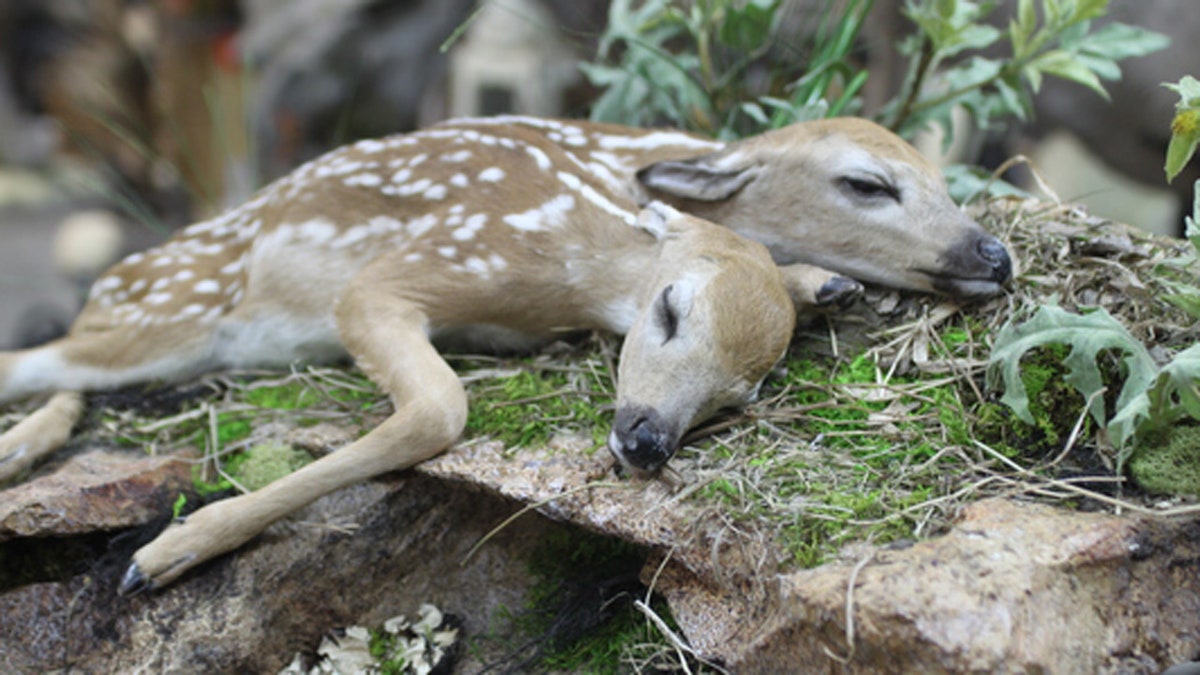
The conjoined fawns discovered in Minnesota in 2016 are the first recorded case of conjoined white-tailed deer brought to full-term and born, according to a recently published study. The fawns have since been mounted on a bed of greenery by a taxidermist. (Minnesota DNR)
A mushroom hunter's discovery of conjoined white-tailed fawns in a Minnesota forest two years ago is being hailed by researchers as a landmark case among oddities in nature.
The fawns, which were stillborn, are believed to have been the first recorded case of a conjoined two-headed deer to have reached full term and born by their mother, according to a study recently published in the science journal American Midland Naturalist.
"It’s never been described before," Lou Cornicelli, co-author of the study and a wildlife research manager for the Minnesota Department of Natural Resources, told FOX9. "There are a few reported cases of two-headed ungulate fetuses, but nothing delivered to term. So, the uniqueness made it special."
In two other previous cases of conjoined white-tailed deer fawns, neither made it through the full pregnancy.

Officials conducted lab tests on the fawns, which revealed the two had separate head-neck regions which rejoined along the spine. (Minnesota DNR)
The discovery was made in May 2016, when a mushroom hunter came across the twins about a mile from the Mississippi River in Freeburg, Minn., located in the southeast portion of the state. The hunter contacted the Minnesota DNR, and the fawns were frozen until a necropsy could be conducted.
MYSTERIOUS SOUTH CAROLINA FISH WITH HUMANLIKE TEETH STUMPS THE INTERNET
Lab tests, including a CT scan and MRI, revealed the fawns had two separate had head-neck regions, which rejoined along the spine. The fawns had normal fur, heads, and legs, but internally had a shared liver, extra spleens, and gastrointestinal tracts, according to study co-author Gino D’Angelo, a researcher at the University of Georgia.

The fawns had normal fur, heads, and legs, according to researchers. (Minnesota DNR)
“Their anatomy indicates the fawns would never have been viable,” D’Angelo told UGA Today. “Yet, they were found groomed and in a natural position, suggesting that the doe tried to care for them after delivery. The maternal instinct is very strong.”
CHEETAHS CHASE TOURISTS AT DUTCH SAFARI PARK AFTER FAMILY GETS OUT OF CAR TO SNAP PICTURES
Conjoined twins are commonly found in domestic animals, especially cattle and sheep, but are rare in other wildlife, according to D'Angelo.

The conjoined fawns discovered in a Minnesota forest in 2016 is the first recorded case of a conjoined white-tailed deer brought to full-term and born, according to a recently published study. (Minnesota DNR)
The conjoined fawns have since been mounted on a bed of greenery by Wild Images In Motion Taxidermy, and will now be positioned as it is just waking from a nap. The mount will eventually be moved to the Minnesota DNR headquarters in St. Paul and placed on public display, according to FOX9.
"We all thought it was pretty neat and were glad to be able to show it to the public," Cornicelli told FOX9. "The taxidermists, Robert Utne and Jessica Brooks, did a great job with the mount and treated it very respectfully."




















